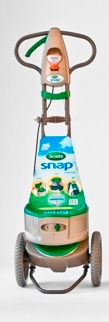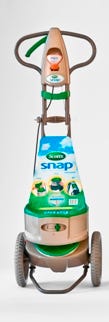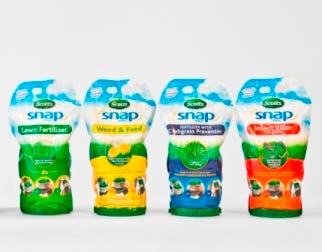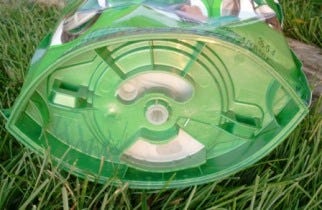Packaging innovation leads to blades of glory
March 11, 2015


Scotts Snap Spreader
The humble lawn spreader has remained virtually unchanged since homeowners first started pushing them across their yards in the 1950s. A hopper holds the seeds or granular fertilizer (which frequently blow off the top or dribble out the bottom, instead of landing precisely where the user wants the material to go), and the homeowner uses the handle to push the rickety thing along while the clunky wheels helped keep it moving. The whole process is messy, uneven, wasteful and (if the fertilizer dust carried on the wind was inhaled) potentially harmful.
Now, The Scotts Co. has debuted the Snap Spreader, a device that improves on both the spreader concept and the packaging holding the product. It is designed for modest lawns measuring less than 5,000 sq ft (slightly more than 1/10 of an acre) and is intended to reduce material waste, simplify use and save storage space. By bringing together staff from its branding team, research and development department and other areas, the company was able to put a product in consumers' hands that improves the way they work to beautify their homesteads.
"The Snap Spreader was the genesis of our team working to meet unmet consumer needs," says Brad Schultz, research principal with The Scotts Co. "Some of the issues we came across with the original spreader were settings, the difficulty involved with opening and pouring bulky bags of fertilizer and users not wanting to come in contact with the product. We set out as a team to address these key consumer issues."
On store shelves, the spreader resembles a conventional lawn spreader, but with a sleeker design and slimmer profile. When the consumer takes the spreader home for use on their lawns, he or she first removes the minimal point-of-purchase materials, consisting of a small hang tag on the handle and a paperboard panel that serves as an informative label as well as a guard to the dispensing mechanism in the hopper. It ships folded for easy transportation and ease of storage in the consumer's garage or shed. It is restored to its full height by unscrewing a thumb nut to raise the handle to the "up" position, then the user tightens the nut to secure the handle. The Snap Pac cartridge snaps into position where the hopper would be situated on a conventional spreader. The consumer flips a switch to lock the cartridge in place then, when ready to use, the consumer pushes the Snap Spreader forward, using a lever at the top to release product only where wanted.
Overall, the benefits of the system are:
• The user does not need to struggle with opening or pouring product from an unwieldy bag into the hopper. The bag is the hopper.
• The Snap Pac cartridge is simple and foolproof to load.
• There are no different spreader settings for different lawncare products.
• Unused product does not need to be poured back into the package for storage.

Scotts Snap Spreader Snap Pac bags
The product came about by bringing personnel together from various departments together to brainstorm and, first and foremost, by keeping the end user in mind.
"The consumer is always first," says Keri Butler, media relations for The Scotts Co. "Everything in our R&D team is charged with answering the question, ‘Where is there an unmet consumer need?' The interest in having a different kind of lawn spreader came from consumer insight that the brand team was looking at. The things that came up were, ‘I would like a simple, easy way to feed my lawn.' ‘I don't have much room for storage.' ‘I don't like having a bag with leftover product.' Our brand and R&D teams are cross-functional, so they worked together to figure out how to meet those needs."
According to Schultz, over the years the company actually has revisited the idea of morphing the original lawn spreader configuration into something more effective and useful to home users, but those ideas never made it much past the drawing board. The Snap Spreader, however, had more success.
"What makes this execution different are the technology advancements in the bag and fitment technology, and the growing number of time-starved consumers," Schultz says.
The company reports that one key to the Snap Spreader innovation is a custom injection-molded HDPE fitment on the bottom of the Snap Pac.

Scotts Snap Spreader fitment
"The fitment in the bottom of the pouch is where all of the metering and on-off control reside," says Schultz."It's spring-loaded and welded together ultrasonically. The metering orifice is the ‘engine' that powers the product. It automatically calibrates so that the user doesn't need to worry about guesswork, or if they're going to over- or under-apply the product. The consumer's worries about burning or damaging their yard, or not delivering enough, are essentially eliminated with the Snap Spreader."
In addition to increasing the functionality of the spreader, the fitment also enables the Snap Pac cartridge to stand upright on store shelves. A die-cut handle at the top makes it easy to tote and insert the cartridge into the spreader.
The Scotts Co. partnered with an outside design firm to come up with the aesthetics and functional aspects of the Snap Spreader itself; then much of the engineering for the device was generated in-house. Teams maintained constant communication to ensure intelligent design.
"It's very intentional on how everything goes together," says Schultz. "We worked with consumer research and industrial-design firms to create something that appealed to both male and female consumers, and something that felt very contemporary."
While the tool offers the same functionality as a conventional spreader, it offers a number of additional enhancements, including the Edge Guard feature, which helps cut waste by keeping products from being applied to sidewalks, pathways, flower beds and other areas. The Snap Pac packaging, however, holds as much in the way of useful innovative features as the Snap Spreader itself. The pouch is an eight-color laminated polyester, a proprietary structure built with longevity in mind.
"Durability is a big concern," says Schultz. "Much of our merchandising is done in outdoor environments, so we have rigid specs about fade resistance and material stability. We needed to design weather-proof product and packaging."
According to Butler, The Scotts Co. was active in ensuring the finished pouch was able to stand the test of time.
"If you were to drive across our campus, you'd see people with pallets of stuff, doing weather testing and checking sun fading" she says. "In the case of lawn food, a retailer might leave a pallet of the Snap Pac cartridges outside all winter, then dust them off in the spring. We have to make sure the package doesn't degrade in those conditions."
The layered pouch also is built to accept high-end graphics for shelf appeal; and other components are engineered to add to its strength and sealability. According to Butler, the company also has weighed environmental factors, balancing the pouch's recycled content and recyclability with durability, printability and other concerns.
The Snap Spreader retails at around $60. However, Butler points out that, because the device is new, various retailers are offering different price points. Some are offering incentives, such as free Snap Pac cartridges with the purchase of the Snap Spreader, to encourage consumer trial. As Schultz points out, "This isn't your dad's spreader."
.
About the Author(s)
You May Also Like


